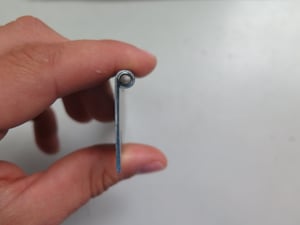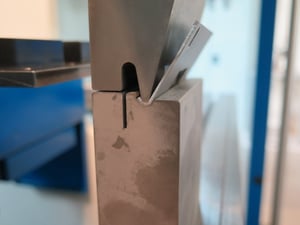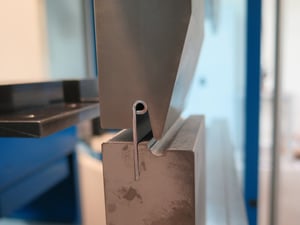 For many of the custom wire and sheet metal forms that Marlin Steel creates, parts tolerances are a major issue. Being able to consistently meet a specified size and shape for parts is crucial for ensuring smooth use of automation and preventing parts rejections.
For many of the custom wire and sheet metal forms that Marlin Steel creates, parts tolerances are a major issue. Being able to consistently meet a specified size and shape for parts is crucial for ensuring smooth use of automation and preventing parts rejections.
Marlin Steel’s manufacturing and engineering teams work to minimize variance between parts to meet tight parts tolerances. However, there are many variable factors that can affect the ability to meet tight parts tolerances, such as:
- Placement of a part by operators on metal forming equipment;
- Thickness of metal wires/sheet metal;
- The type of metal the wire/sheet metal is made of;
- Grain direction of a metal workpiece; and
- Desired inside diameter of a bend.
Recently, one customer contacted Marlin Steel to create a series of sheet metal hinge assemblies made from aluminum. For this particular assembly, the client was requesting that the aluminum hinge assembly meet an extraordinarily tight parts tolerance.
Here’s what Marlin did to minimize parts variations to meet the client’s aluminum tolerance requirements:
Using Bottom Bending to Ensure Consistent Shapes in the Hinge
 To help ensure that the curve for the rounded hinge opening would be a consistent angle with a minimum of effort, Marlin’s manufacturing team used a “bottom bending” method. Basically, this means that when the sheet metal plate is put in Marlin’s press brake, it presses the sheet metal all the way into the die rather than just partway into the die (this alternate process is called “air bending”).
To help ensure that the curve for the rounded hinge opening would be a consistent angle with a minimum of effort, Marlin’s manufacturing team used a “bottom bending” method. Basically, this means that when the sheet metal plate is put in Marlin’s press brake, it presses the sheet metal all the way into the die rather than just partway into the die (this alternate process is called “air bending”).
The backside of the die was used as the backstop for this initial bend because the loop was so close to the end of the sheet metal workpiece. Doing this helped to limit the variability of each hinge. To close the loop, the workpiece was slotted into a cavity in the back of the die as the press brake pushed the bent end down. The slot in the die was cut deep to help ensure that the hinge would be perfectly upright as the ram came down. A groove cut into the ram helped to ensure that the outside of the hinge’s loop would be consistently round in shape.
Why Use a Press Brake to Shape Stainless Steel Hinges?
 There are other methods of rolling a tight loop into a piece of sheet metal, such as hammering the metal around a narrow bar of metal by hand. So, why did Marlin create a custom die and ram head for its press brake machine rather than go with the manual shaping solution? There are a few reasons, including:
There are other methods of rolling a tight loop into a piece of sheet metal, such as hammering the metal around a narrow bar of metal by hand. So, why did Marlin create a custom die and ram head for its press brake machine rather than go with the manual shaping solution? There are a few reasons, including:
- Employee Safety. Trying to shape a piece of metal by hand can be dangerous work. Even discounting the risk of dropping a hammer or a heated piece of metal onto oneself, the repetitive motion and impacts involved can, over time, cause stress injuries and minor fractures. Having a machine make the bends is simply safer for Marlin’s people.
- Part Accuracy. While the press brake’s bottom bending method isn’t perfect, considering the potential for the aluminum to slightly “spring back” after bending, it is far more consistent and reliable than forming the metal by hand. Also, the entire length of the hinge will have a consistent shape, where hammering the metal in place would create abnormalities in the workpiece.
- Speed of Assembly. Trying to bend a piece of metal by hand, even something “lightweight” like aluminum, is incredibly difficult and time-consuming. However, with a press brake, a hinge shape can be put into a piece of sheet metal in seconds. The press brake can exert dozens of tons of force, easily reshaping the metal. Doing the same by hand would require much more time and effort.
- The Tightness of the Bend. One of the major challenges in this hinge design was that the loop for the hinge was so small—it strained the limits of the internal radius for a bend in aluminum. Any bar thin enough to be used to shape the inside of the loop would be too fragile to be used to shape metal. Using a custom-cut press brake die and ram assembly allowed Marlin’s manufacturing team to make the tiny loop consistently with ease.
This particular hinge manufacturing process was a challenge because of how small the loop needed to be and how tight the client’s parts tolerance requirements were. However, Marlin’s custom manufacturing solution was able to provide the client with a custom metal form that satisfied their needs with a minimal delay for tooling and manufacturing—preventing delays in the client’s own manufacturing process.
Do you need a custom metal form that can meet tight parts tolerances as soon as possible? Reach out to the team at Marlin to get started.



.gif)


